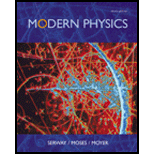
Concept explainers
(a)
Supply the missing neutrinos in
(a)
Answer to Problem 8P
The missing neutrinos in
Explanation of Solution
Consider table 15.2 and refer equation 15.1,
The missing neutrinos in pion are Muon-neutrino.
Here,
Conclusion:
In this case, the muon-lepton is conserved.
Therefore, the missing neutrinos in
(b)
Supply the missing neutrinos in
(b)
Answer to Problem 8P
The missing neutrinos in
Explanation of Solution
Consider table 15.2.
The missing neutrino in Kaon is Muon-neutrino.
Here,
Conclusion:
In this case, the muon-lepton is conserved.
Therefore, the missing neutrinos in
(c)
Supply the missing neutrinos in
(c)
Answer to Problem 8P
The missing neutrinos in
Explanation of Solution
Using table 15.2,
The missing neutrino is electron-neutrino.
Here,
Conclusion:
In this case, the electron-lepton is conserved.
Therefore, the missing neutrinos in
(d)
Supply the missing neutrinos in
(d)
Answer to Problem 8P
The missing neutrinos in
Explanation of Solution
Using table 15.2,
The missing neutrino is electron-neutrino.
Here,
Conclusion:
In this case, the electron-lepton is conserved.
Therefore, the missing neutrinos in
(e)
Supply the missing neutrinos in
(e)
Answer to Problem 8P
The missing neutrinos in
Explanation of Solution
Using table 15.2,
The missing neutrino is electron-neutrino.
Here,
Conclusion:
In this case, the muon-lepton is conserved.
Therefore, the missing neutrinos in
(f)
Supply the missing neutrinos in
(f)
Answer to Problem 8P
The missing neutrinos in
Explanation of Solution
Using table 15.2,
The missing neutrino is electron-neutrino.
Here,
Conclusion:
In this case, the muon-lepton and electron-lepton are conserved.
Therefore, the missing neutrinos in
Want to see more full solutions like this?
Chapter 15 Solutions
Modern Physics
- A spectra is a graph that has amplitude on the Y-axis and frequency on the X-axis. A harmonic spectra simply draws a vertical line at each frequency that a harmonic would be produced. The height of the line indicates the amplitude at which that harmonic would be produced. If the Fo of a sound is 125 Hz, please sketch a spectra (amplitude on the Y axis, frequency on the X axis) of the harmonic series up to the 4th harmonic. Include actual values on Y and X axis.arrow_forwardSketch a sign wave depicting 3 seconds of wave activity for a 5 Hz tone.arrow_forwardSketch a sine wave depicting 3 seconds of wave activity for a 5 Hz tone.arrow_forward
- The drawing shows two long, straight wires that are suspended from the ceiling. The mass per unit length of each wire is 0.050 kg/m. Each of the four strings suspending the wires has a length of 1.2 m. When the wires carry identical currents in opposite directions, the angle between the strings holding the two wires is 20°. (a) Draw the free-body diagram showing the forces that act on the right wire with respect to the x axis. Account for each of the strings separately. (b) What is the current in each wire? 1.2 m 20° I -20° 1.2 marrow_forwardplease solve thisarrow_forwardplease solve everything in detailarrow_forward
- 6). What is the magnitude of the potential difference across the 20-02 resistor? 10 Ω 11 V - -Imm 20 Ω 10 Ω 5.00 10 Ω a. 3.2 V b. 7.8 V C. 11 V d. 5.0 V e. 8.6 Varrow_forward2). How much energy is stored in the 50-μF capacitor when Va - V₁ = 22V? 25 µF b 25 µF 50 µFarrow_forward9). A series RC circuit has a time constant of 1.0 s. The battery has a voltage of 50 V and the maximum current just after closing the switch is 500 mA. The capacitor is initially uncharged. What is the charge on the capacitor 2.0 s after the switch is closed? R 50 V a. 0.43 C b. 0 66 C c. 0.86 C d. 0.99 C Carrow_forward
- 1). Determine the equivalent capacitance of the combination shown when C = 12 pF. +11/20 2C C Carrow_forward3). When a capacitor has a charge of magnitude 80 μC on each plate the potential difference across the plates is 16 V. How much energy is stored in this capacitor when the potential difference across its plates is 42 V? a. 1.0 mJ b. 4.4 mJ c. 3.2 mJ d. 1.4 mJ e. 1.7 mJarrow_forward5). A conductor of radius r, length & and resistivity p has resistance R. It is melted down and formed into a new conductor, also cylindrical, with one fourth the length of the original conductor. The resistance of the new conductor is a. 1 R 161 b. 1 R C. R d. 4R e. 16Rarrow_forward
 College PhysicsPhysicsISBN:9781938168000Author:Paul Peter Urone, Roger HinrichsPublisher:OpenStax College
College PhysicsPhysicsISBN:9781938168000Author:Paul Peter Urone, Roger HinrichsPublisher:OpenStax College Principles of Physics: A Calculus-Based TextPhysicsISBN:9781133104261Author:Raymond A. Serway, John W. JewettPublisher:Cengage Learning
Principles of Physics: A Calculus-Based TextPhysicsISBN:9781133104261Author:Raymond A. Serway, John W. JewettPublisher:Cengage Learning Physics for Scientists and Engineers with Modern ...PhysicsISBN:9781337553292Author:Raymond A. Serway, John W. JewettPublisher:Cengage Learning
Physics for Scientists and Engineers with Modern ...PhysicsISBN:9781337553292Author:Raymond A. Serway, John W. JewettPublisher:Cengage Learning University Physics Volume 3PhysicsISBN:9781938168185Author:William Moebs, Jeff SannyPublisher:OpenStax
University Physics Volume 3PhysicsISBN:9781938168185Author:William Moebs, Jeff SannyPublisher:OpenStax College PhysicsPhysicsISBN:9781305952300Author:Raymond A. Serway, Chris VuillePublisher:Cengage Learning
College PhysicsPhysicsISBN:9781305952300Author:Raymond A. Serway, Chris VuillePublisher:Cengage Learning College PhysicsPhysicsISBN:9781285737027Author:Raymond A. Serway, Chris VuillePublisher:Cengage Learning
College PhysicsPhysicsISBN:9781285737027Author:Raymond A. Serway, Chris VuillePublisher:Cengage Learning





